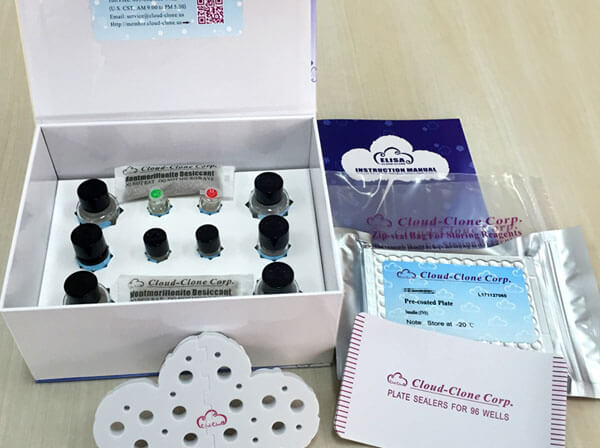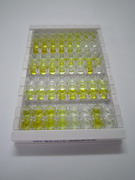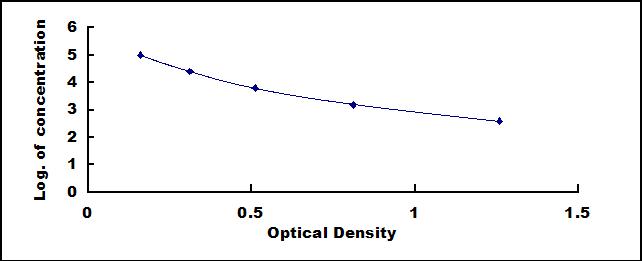ELISA Kit for Diacylglycerol (DAG) 

DG; Diglyceride
- UOM
- FOB US$ 571.00 US$ 816.00 US$ 3,672.00 US$ 6,936.00 US$ 57,120.00
- Quantity
Overview
Properties
- Product No.CEC038Ge
- Organism SpeciesPan-species (General) Same name, Different species.
- ApplicationsEnzyme-linked immunosorbent assay for Antigen Detection.
Research use only - DownloadInstruction Manual
- CategorySignal transductionEndocrinologyHepatologyGastroenterologyNutrition metabolismHormone metabolism
Sign into your account
Share a new citation as an author
Upload your experimental result
Review

Contact us
Please fill in the blank.
Recovery
Matrices listed below were spiked with certain level of Diacylglycerol (DAG) and the recovery rates were calculated by comparing the measured value to the expected amount of Diacylglycerol (DAG) in samples.
| Matrix | Recovery range (%) | Average(%) |
| serum(n=5) | 81-89 | 85 |
| EDTA plasma(n=5) | 80-91 | 86 |
| heparin plasma(n=5) | 89-103 | 96 |
Precision
Intra-assay Precision (Precision within an assay): 3 samples with low, middle and high level Diacylglycerol (DAG) were tested 20 times on one plate, respectively.
Inter-assay Precision (Precision between assays): 3 samples with low, middle and high level Diacylglycerol (DAG) were tested on 3 different plates, 8 replicates in each plate.
CV(%) = SD/meanX100
Intra-Assay: CV<10%
Inter-Assay: CV<12%
Linearity
The linearity of the kit was assayed by testing samples spiked with appropriate concentration of Diacylglycerol (DAG) and their serial dilutions. The results were demonstrated by the percentage of calculated concentration to the expected.
| Sample | 1:2 | 1:4 | 1:8 | 1:16 |
| serum(n=5) | 78-92% | 88-95% | 90-102% | 85-101% |
| EDTA plasma(n=5) | 82-105% | 79-91% | 79-103% | 89-96% |
| heparin plasma(n=5) | 93-101% | 85-99% | 78-101% | 90-97% |
Stability
The stability of kit is determined by the loss rate of activity. The loss rate of this kit is less than 5% within the expiration date under appropriate storage condition.
To minimize extra influence on the performance, operation procedures and lab conditions, especially room temperature, air humidity, incubator temperature should be strictly controlled. It is also strongly suggested that the whole assay is performed by the same operator from the beginning to the end.
Reagents and materials provided
| Reagents | Quantity | Reagents | Quantity |
| Pre-coated, ready to use 96-well strip plate | 1 | Plate sealer for 96 wells | 4 |
| Standard | 2 | Standard Diluent | 1×20mL |
| Detection Reagent A | 1×120µL | Assay Diluent A | 1×12mL |
| Detection Reagent B | 1×120µL | Assay Diluent B | 1×12mL |
| TMB Substrate | 1×9mL | Stop Solution | 1×6mL |
| Wash Buffer (30 × concentrate) | 1×20mL | Instruction manual | 1 |
Assay procedure summary
1. Prepare all reagents, samples and standards;
2. Add 50µL standard or sample to each well.
And then add 50µL prepared Detection Reagent A immediately.
Shake and mix. Incubate 1 hour at 37°C;
3. Aspirate and wash 3 times;
4. Add 100µL prepared Detection Reagent B. Incubate 30 minutes at 37°C;
5. Aspirate and wash 5 times;
6. Add 90µL Substrate Solution. Incubate 10-20 minutes at 37°C;
7. Add 50µL Stop Solution. Read at 450 nm immediately.

Test principle
This assay employs the competitive inhibition enzyme immunoassay technique. A monoclonal antibody specific to Diacylglycerol (DAG) has been pre-coated onto a microplate. A competitive inhibition reaction is launched between biotin labeled Diacylglycerol (DAG) and unlabeled Diacylglycerol (DAG) (Standards or samples) with the pre-coated antibody specific to Diacylglycerol (DAG). After incubation the unbound conjugate is washed off. Next, avidin conjugated to Horseradish Peroxidase (HRP) is added to each microplate well and incubated. The amount of bound HRP conjugate is reverse proportional to the concentration of Diacylglycerol (DAG) in the sample. After addition of the substrate solution, the intensity of color developed is reverse proportional to the concentration of Diacylglycerol (DAG) in the sample.
Giveaways
Increment services
Citations
- Wogonin ameliorates lipotoxicity-induced apoptosis of cultured vascular smooth muscle cells via interfering with DAG-PKC pathwayNature: 2011120a
- Maternal stress predicts altered biogenesis and the profile of mitochondrial proteins in the frontal cortex and hippocampus of adult offspring ratsPubMed: 26143539
- Aryl Hydrocarbon Receptor Plays Protective Roles against High Fat Diet (HFD)-induced Hepatic Steatosis and the Subsequent Lipotoxicity via Direct Transcriptional ReCavia (Guinea pig )lation of Socs3 Gene ExpressionPubmed:26865635
- Pigment Epithelium-Derived Factor (PEDF) Improves Ischemic Cardiac Functional Reserve Through Decreasing Hypoxic Cardiomyocyte Contractility Through PEDF Receptor (PEDF-R).pubmed:27413044
- PEDF protects cardiomyocytes by promoting FUNDC1‑mediated mitophagy via PEDF-R under hypoxic conditionPubmed:29512692
- Bouchardatine analogue alleviates NAFLD/NASH in high fat fed mice via blunting ATP synthase activityPubmed: 31113010
- Gut Akkermansia muciniphila ameliorates non-alcoholic fatty liver disease by L-aspartate via interaction with liver
- The expression of diacylglycerol kinase isoforms α and ζ correlates with the progression of experimental autoimmune encephalomyelitis in rats34312706











